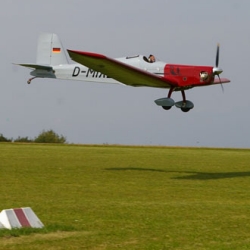EEL ULF-2
| EEL ULF-2 | |
|---|---|

|
|
| Type: | Microlight |
| Design country: | |
| Manufacturer: |
EEL |
| First flight: |
October 30, 1993 |
| Production time: |
since 1994 in individual production |
| Number of pieces: |
about 20 |
EEL ULF-2 is a single-seat, ultra-light motor glider designed for amateur construction.
history
Dieter Reich, Horst Fischer and Anton Quanz have been working together since 1976 with the development and testing of light aircraft (EEL), and in 1977 they developed the previous model, the ULF-1 and later the ULF-2. The aircraft has been type-approved in Germany by the German Aero Club since February 20, 1995 . To date, more than 89 plan sets of the building documents have been sold. Twelve motor gliders were completed.
construction
The ULF-2 is a tailwheel - low-wing aircraft in wood construction . The drive is the 2-cylinder boxer engine of the Citroën Visa , supplemented by a belt drive and a three-blade propeller with 24 kW / 652 cm³. The construction is optimized for good flight characteristics and low fuel consumption.
Technical specifications
| Parameter | Data |
|---|---|
| crew | 1 |
| length | 6.25 m |
| span | 11 m |
| height | 1.6 m |
| Wing area | 13.90 m² |
| Wing loading | 23.2 kg / m² |
| Elongation | 8.7 |
| Glide ratio | 14th |
| Slightest sinking | 1.1 m / s at? km / h |
| Max. Rate of climb | 3.0 m / s |
| Max. Takeoff mass | 322.5 kg |
| Cruising speed at max. Continuous output | 120 km / h |
| Top speed | 140 km / h |
| Economic cruising speed | 100 km / h |
| Range | 500 km |
| fuel | Regular unleaded petrol, min. 91 |
| Tank capacity | 33 l |
| Consumption at 100 km / h | 6 l / h |
| Engine | a Citroën Visa V06 / 665 or V06 / 644 |
| Take-off run | 80 m |
| Minimum speed | 50 km / h |
See also
Web links
- http://www.eel.de/ - Developer's site